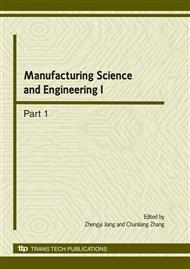p.200
p.204
p.209
p.214
p.219
p.227
p.231
p.236
p.240
Solution of Singularity Points in Strip Rolling by Rigid Plasticity Finite Element Method
Abstract:
The concept of the first and the second singularity point was introduced in the paper. The singularity points would lead to the iteration divergence in the solution of rolling by rigid plasticity finite element method. Double velocity model and parabolic model of relative slip velocity were proposed for solution of the first and the second singularity point respectively. The influence of the models to improve the effects of singularity point on calculating time and iteration step was discussed according to the practical strip rolling condition. The results showed that for the element numbers from 200 to 2000, the iteration step and total calculating time was reduced about 8~67% by the double velocity model in the same condition compared to normal model for the solution of first singularity point. The iteration step and calculating time was reduced about 15~61% with the parabolic model of relative slip velocity. The double velocity model and parabolic model of relative slip velocity could be used to improve the convergence and increase efficiency of the solution in strip rolling by rigid plasticity finite element method.
Info:
Periodical:
Pages:
219-226
Citation:
Online since:
March 2010
Authors:
Price:
Сopyright:
© 2010 Trans Tech Publications Ltd. All Rights Reserved
Share:
Citation:


